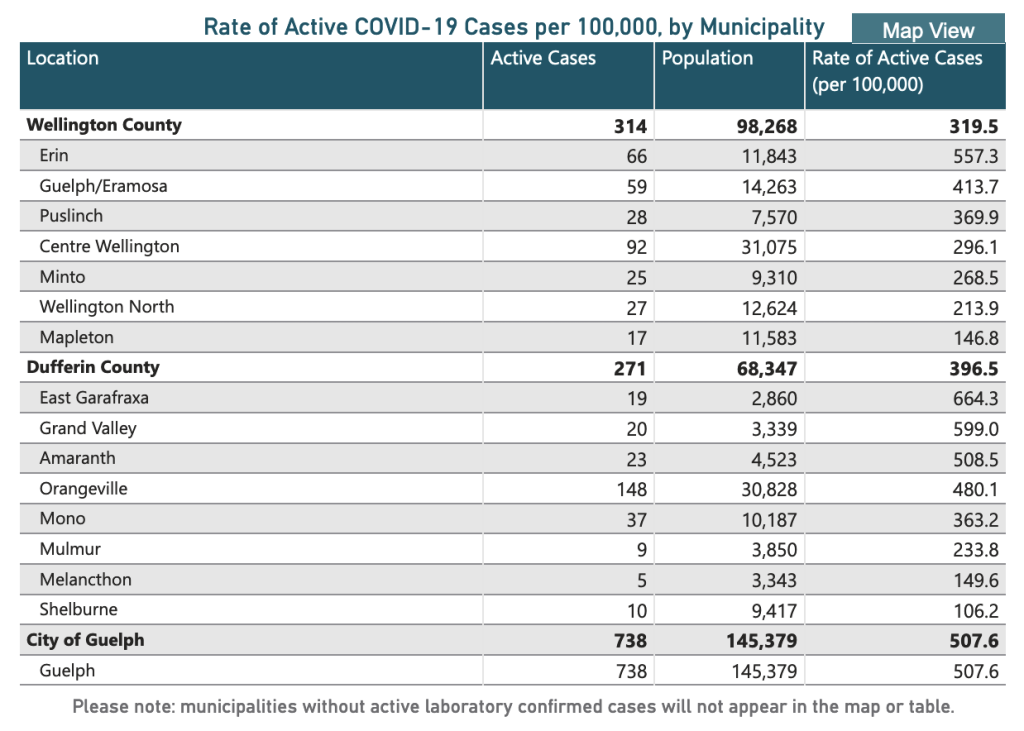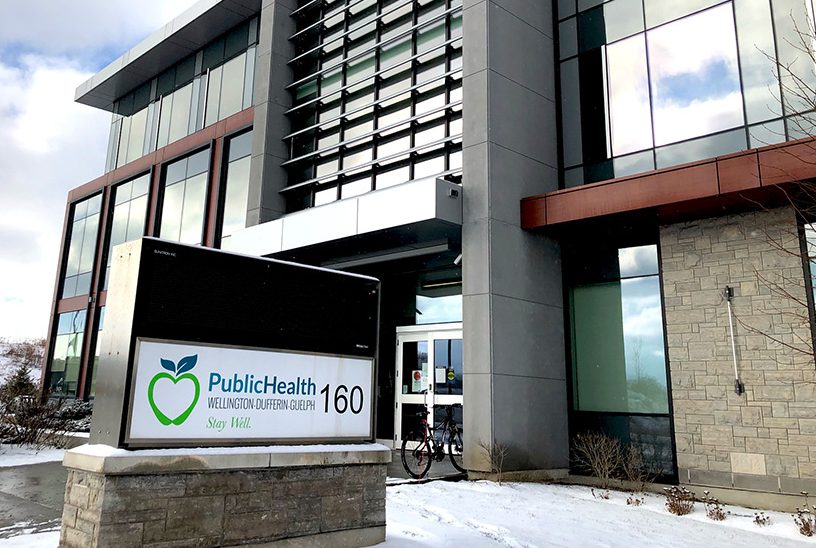WELLINGTON COUNTY – Wellington-Dufferin-Guelph Public Health (WDGPH) is reporting 821 new COVID-19 cases between Christmas Eve and Dec. 27.
This is the second week in a row active cases have more than doubled in the region, with total active cases sitting at 1,367 as of Dec. 28.
One week ago there were 536 cases, and two weeks ago there were 224 cases.
Current active cases have far surpassed the reported number of cases at this time least year, when there were 302 active cases in the region.
The previous record high of 739 cases, reported on April 19, 2020, has also been surpassed.
Following a decline in reported active cases — to 29 cases throughout the entire WDGPH region on Nov. 2 — the rapid resurgence of the coronavirus is being blamed by health officials on the highly virulent Omicron variant.
The case rate per 100,000 population has, as of Dec. 26, continued to balloon to 366 from 36.5 earlier this month.
The rate of COVID-19 tests returning positive for the virus also continues to rise, from 4.2% on Dec. 9 to 15.1% as of Dec. 24.
The region’s effective reproduction number, used to measure how many additional cases spread or result from a single case, is trending downward from 1.19 between Dec. 11 and 18 to 1.03 as of Dec. 26. A value of one or above means cases will increase; below one and spread will eventually cease.
The number of people hospitalized with COVID-19 in the region is also growing, with 13 individuals hospitalized with the virus, of which three are in an ICU as of Dec. 23. Hospitalization data won’t be updated again until the new year and vaccination statuses are not disclosed.
According to provincial data, as of the morning of Dec. 24 (the most recent date showing updated data), there are 223 unvaccinated persons hospitalized with COVID-19 across the province, of which 85 are in an ICU.
Two-dose vaccinated individuals account for 181 hospitalizations across the province, with 28 an ICU.
Omicron variant breakdown
WDGPH identified the region’s first case of the COVID-19 Omicron variant on Dec. 9 in a fully-vaccinated Guelph male aged 12 to 20.
According to Public Health Ontario (PHO) data, as of Dec. 27, there have been 38 Omicron cases identified by “genomic analysis” in the health region.
Probable Omicron cases – cases not identified by whole genome sequencing – have reached 187 in WDGPH region as of Dec. 21, according to PHO data.
Probable cases are determined by looking for the absence of certain amino acids (molecules), in a method known as “spike gene target failure,” because nearly all of the mutated COVID-19 Omicron specimens processed by PHO labs as of Dec. 6 have a “deletion of amino acid position H69 and V70 within the spike protein.”
An unspecified portion of the cases with ‘S’ gene target failure will be sent for whole genome sequencing, depending on the viral load of the test specimen.
WDGPH estimates Omicron represents 22% of all COVID-19 cases between Dec. 19 and 25 in the health region.
Local trends
Wellington County had 178 newly-confirmed cases over the Dec. 24 to 27 reporting period, with 314 active cases in the county as of Dec. 28.
That is the highest total yet for active cases in Wellington County. The record during previous waves of the pandemic was 122, set on April 19.
There are 738 active cases in Guelph and 271 in Dufferin County as of Dec. 28.
The death toll for those who died with the virus, remains unchanged from last week’s total of 128 people, including 38 in Wellington County.

Municipality-specific active COVID-19 case counts as of Dec. 28, 2021. (WDGPH image)
Vaccinations
Since Dec. 20, another 615 people have become two-dose vaccinated in the WDGPH region, bringing the total as of Dec. 28 to 241,561 or 82% of the population aged five or older.
There are 16,666 people aged five are older in the region who have received their first dose, as of Dec. 28.
According to Ontario’s COVID-19 Advisory Science Table data, as of Dec. 27, there were 1,035 new cases every day per million people in those unvaccinated, compared with 881 cases per day in those fully vaccinated.
The data concludes there’s a 15% risk reduction of contracting a case with two vaccine doses. The reduction in the risk of being hospitalized with two doses is 92%.
In Wellington County 81% of eligible residents, including those aged five to 11, are two-dose vaccinated as of Dec. 28.
Less than 7,372 of Mapleton’s 10,532 residents (70%) have received a single vaccine dose, as of Dec. 28, making the municipality the leader for the lowest vaccine uptake in the county.
Across the region, according to WDGPH data, there are an estimated 11,523 high school students who are vaccinated with two doses; 277 with only a single dose; and 2,050 students who have not yet received a single dose.
In elementary schools in the WDGPH catchment area, there are an estimated 30,038 students who are now eligible for vaccination, according to WDGPH data.
Of that group, 16,190 elementary students are at least vaccinated with a single dose as of Dec. 28. From that group, there are an estimated 5,466 elementary students who are fully vaccinated.
The remaining 13,848 students have not yet received a single dose.
Outbreaks
As of Dec. 28 outbreaks have been declared within Avalon Care Centre in Orangeville, Caressant Care Arthur, Guelph General Hospital, Homewood Health Centre in Guelph, Royal Terrace long-term care in Palmerston, Village of Riverside Glen in Guelph, and Wellington Terrace Long-Term Care Home in Aboyne.
An outbreak has also been declared at Greystones Restaurant and Lounge in Orangeville.




